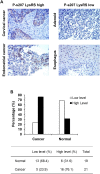Serine 207 phosphorylated lysyl-tRNA synthetase predicts disease-free survival of non-small-cell lung carcinoma
- PMID: 29029422
- PMCID: PMC5630322
- DOI: 10.18632/oncotarget.18053
Serine 207 phosphorylated lysyl-tRNA synthetase predicts disease-free survival of non-small-cell lung carcinoma
Erratum in
-
Correction: Serine 207 phosphorylated lysyl-tRNA synthetase predicts disease-free survival of non-small-cell lung carcinoma.Oncotarget. 2018 Nov 16;9(90):36250. doi: 10.18632/oncotarget.26387. eCollection 2018 Nov 16. Oncotarget. 2018. PMID: 30546840 Free PMC article.
Abstract
It has been shown that various tRNA synthetases exhibit non-canonical activities unrelated to their original role in translation. We have previously described a signal transduction pathway in which serine 207 phosphorylated lysyl-tRNA synthetase (P-s207 LysRS) is released from the cytoplasmic multi-tRNA synthetase complex (MSC) into the nucleus, where it activates the transcription factor MITF in stimulated cultured mast cells and cardiomyocytes. Here we describe a similar transformation of LysRS due to EGFR signaling activation in human lung cancer. Our data shows that activation of the EGFR results in phosphorylation of LysRS at position serine 207, its release from the MSC and translocation to the nucleus. We then generated a P-s207 LysRS rabbit polyclonalantibody and tested 242 tissue micro-array samples derived from non-small-cell lung cancer patients. Highly positive nuclear staining for P-s207 LysRS was noted in patients with EGFR mutations as compared to WT EGFR patients and was associated with improved mean disease-free survival (DFS). In addition, patients with mutated EGFR and negative lymph node metastases had better DFS when P-s207 LysRS was present in the nucleus. The data presented strongly suggests functional and prognostic significance of P-s207 LysRS in non-small-cell lung cancer.
Keywords: EGFR; LysRS; P-s207 LysRS; multi-synthetase complex; non-small-cell lung cancer.
Conflict of interest statement
CONFLICTS OF INTEREST The authors have declared that no conflicts of interest exist.
Figures







References
-
- Bandyopadhyay AK, Deutscher MP. Complex of aminoacyl-transfer RNA synthetases. J Mol Biol. 1971;60:113–122. - PubMed
-
- Yannay-Cohen N, Carmi-Levy I, Kay G, Yang CM, Han JM, Kemeny DM, Kim S, Nechushtan H, Razin E. LysRS serves as a key signaling molecule in the immune response by regulating gene expression. Mol Cell. 2009;34:603–611. - PubMed
-
- Lee YN, Nechushtan H, Figov N, Razin E. The function of lysyl-tRNA synthetase and Ap4A as signaling regulators of MITF activity in FcepsilonRI-activated mast cells. Immunity. 2004;20:145–151. - PubMed
LinkOut - more resources
Full Text Sources
Other Literature Sources
Molecular Biology Databases
Research Materials
Miscellaneous

